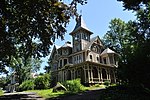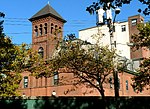Fair Haven Heights, New Haven
Neighborhoods in New Haven, Connecticut
Fair Haven Heights, or simply the Heights, is a residential and light industrial neighborhood in the eastern part of the city of New Haven, Connecticut, located east of the Quinnipiac River. Fair Haven Heights is not to be confused with the adjacent Fair Haven neighborhood west of the river. The area is bordered on the west by the Quinnipiac River, on the north by Route 80, on the east by the town of East Haven, and on the south by Ferry Street and Warwick Avenue. The main through routes are Quinnipiac Avenue, East Grand Avenue, and Eastern Street
Excerpt from the Wikipedia article Fair Haven Heights, New Haven (License: CC BY-SA 3.0, Authors).Fair Haven Heights, New Haven
Revere Street, New Haven
Geographical coordinates (GPS) Address Nearby Places Show on map
Geographical coordinates (GPS)
| Latitude | Longitude |
|---|---|
| N 41.302 ° | E -72.885 ° |
Address
Revere Street 67
06513 New Haven
Connecticut, United States
Open on Google Maps









